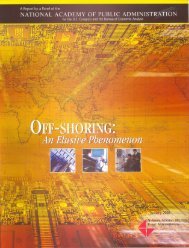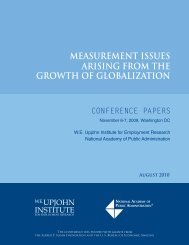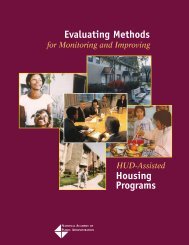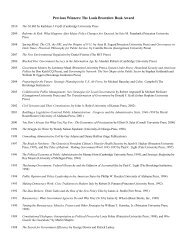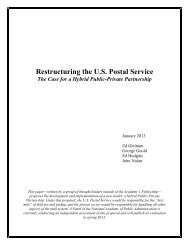High-Performance Partnerships - National Academy of Public ...
High-Performance Partnerships - National Academy of Public ...
High-Performance Partnerships - National Academy of Public ...
You also want an ePaper? Increase the reach of your titles
YUMPU automatically turns print PDFs into web optimized ePapers that Google loves.
PARTNERSHIP CASE STUDIES<br />
chapter three<br />
Keys to Success<br />
In Richmond, like many cities, there is a statistical<br />
correlation between vacant or abandoned<br />
housing and crime rates. Thus, reducing crime<br />
was part <strong>of</strong> the goal for stabilizing the neighborhoods.<br />
From 2000 to 2002, crime fell by 15<br />
percent in the six NIB areas, compared to 5<br />
percent for the rest <strong>of</strong> the city.<br />
Unfortunately, neighborhood revitalization is<br />
not achieved quickly. Decades <strong>of</strong> decline cannot<br />
be reversed in a few short years. NIB’s<br />
long-term success will be judged by a steady<br />
increase in home ownership rates, housing values,<br />
and resident satisfaction. Based on current<br />
data and anecdotal evidence, the partnership<br />
is on track to achieve its goal.<br />
Challenges<br />
Given its relative youth, NIB has not reached<br />
full maturity as a high-performance partnership.<br />
Long-term stability is not yet assured.<br />
The trust level among partners has increased<br />
dramatically, but still is tenuous. Effective and<br />
timely communication has proved challenging.<br />
The sheer number <strong>of</strong> partners contributes to<br />
the difficulty <strong>of</strong> keeping everyone informed<br />
and obtaining timely input.<br />
NIB works in extremely distressed conditions.<br />
Some <strong>of</strong> these neighborhoods have had little or<br />
no private investment for many years. NIB has<br />
harvested “low hanging fruit” and must ratchet<br />
up its performance to continue revitalizing<br />
neighborhoods. Some partners have not been<br />
able to meet this demanding standard and program<br />
adjustments are underway. However, the<br />
community strongly supports NIB and has<br />
fought hard to preserve the partnership.<br />
Although only three years old, NIB has<br />
achieved significant successes. The timing and<br />
environment were ripe for a radical change in<br />
how Richmond and the nonpr<strong>of</strong>it community<br />
did business. All sectors—public, nonpr<strong>of</strong>it,<br />
and civic—were committed to substantially<br />
altering the city’s strategy to neighborhood<br />
revitalization because the traditional approach<br />
had not produced lasting results. Competition<br />
among nonpr<strong>of</strong>its for limited resources had<br />
been the norm. The Local Initiative Support<br />
Corporation spearheaded significant change in<br />
how the community development corporations<br />
interacted. It led the effort to forge close<br />
working relationships in the nonpr<strong>of</strong>it community.<br />
The public and civic sectors also<br />
enjoyed strong leadership that propelled the<br />
partnership’s movement in its early stages.<br />
Elected <strong>of</strong>ficials made very difficult choices<br />
when redirecting resources to targeted neighborhoods.<br />
Doing so was made easier because<br />
the partnership is inclusive and data driven.<br />
Keys to long-term success will be using those<br />
same data sources to track neighborhood<br />
progress over time and sustaining the leadership<br />
so critical to NIB’s initial outcomes.<br />
50 Powering the Future: <strong>High</strong>-<strong>Performance</strong> <strong>Partnerships</strong>




